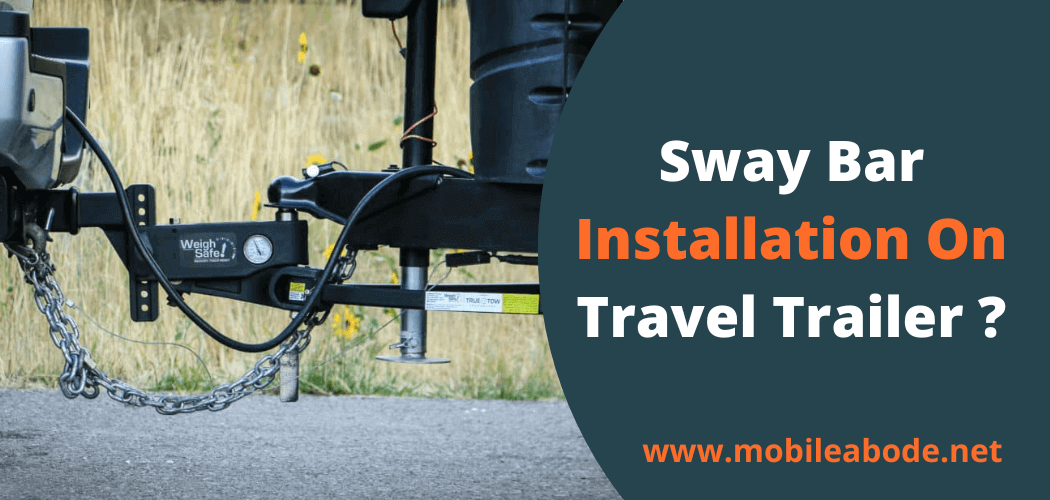Installing a sway bar on a travel trailer can help to improve the handling and stability while towing but it can be a daunting task. But with the right tools and some guidance, it can be done in no time!
In this blog post, we’ll walk you through the process of installing a sway bar on your travel trailer. So if you’re looking to improve your tow vehicle’s handling, read on for instructions on how to install a sway bar!
What Is Sway Bar and What Does It Do For Your Trailer Hitch System? A sway bar is a metal rod that’s attached to your trailer’s axle and frame. It helps to keep the trailer from swinging side to side, which can improve its stability and handling while you’re towing it.
If your trailer doesn’t have a sway bar or if it’s not properly installed, it can cause the trailer to swing from side to side, which can be dangerous. A properly installed sway bar will help to keep the trailer stable and improve its handling while you’re on the road.
So, now that you know what a sway bar is and what it does, let’s take a look at how to install one on your travel trailer.
How to Install Sway Bar On Travel Trailer?
A sway bar is an important part of your trailer’s suspension system and can help to improve its handling and stability.
In this blog post, we’ll show you how to install a sway bar on your travel trailer in just a few steps. So, without further ado, let’s get started!
Tools and Materials Needed:
- Wrench
- Socket set
- Measuring tape
- Drill
- Drill bit (1/4 inch or larger)
- Sway bar kit (including brackets, bolts, and nuts)
Installation Steps
- Park your trailer on level ground and put the jack stands under the frame to support it.
- Measure the distance between the brackets that will be attached to the axle and frame. This will help you determine how long the sway bar needs to be.
- Cut the sway bar to size using a hacksaw or a metal cutting blade.
- Drill holes in the brackets that will be attached to the axle and frame. These holes should be big enough to accommodate the bolts that will be used to attach the brackets to the axle and frame.
- Attach the brackets to the axle and frame using the bolts and nuts that are provided in the kit.
- Attach the sway bar to the brackets and tighten all of the bolts.
- Remove the jack stands and lower the trailer down.
- Test the trailer by pulling it forward and then reversing. The trailer should not swing from side to side. If it does, make sure that the bolts are tightened and that the sway bar is properly installed.
Installing a sway bar on your travel trailer is a relatively simple task that can be completed in just a few steps. By following these instructions, you’ll be able to improve the handling and stability of your trailer while you’re on the road.
So, if you’re looking to make your trailer safer and easier to tow, be sure to install a sway bar properly!
How to determine if your trailer needs a sway bar?
There are a few ways to tell if your trailer needs a sway bar.
- One way is to observe how the trailer behaves while you’re towing it. If the trailer seems to swing from side to side, then it’s likely that a sway bar would be beneficial.
- Another way to tell if your trailer needs a sway bar is to look at the wear on the tires. If the wear is uneven, with more wear on one side of the tire than the other, then it’s likely that a sway bar would be beneficial.
If you’re unsure whether or not your trailer needs a sway bar, we recommend consulting with a qualified trailer technician. They’ll be able to inspect your trailer and give you their professional opinion on whether or not a sway bar would be beneficial.
Installing a sway bar on your trailer is a relatively simple and inexpensive task that can have a big impact on the safety and handling of your trailer.
Tips for Using and Maintaining Sway Bar Hitch System?
Here are a few tips for using and maintaining your sway bar hitch system:
- Always check the bolts and brackets that attach the sway bar to the trailer before each trip. These bolts should be checked periodically and tightened if necessary.
- When loading or unloading your trailer, make sure that the weight is evenly distributed. Uneven distribution of weight can cause the trailer to swing from side to side, which can put stress on the sway bar and brackets.
- When backing up your trailer, go slowly and make wide turns.
- When making any sharp turns, slow down and take them wide. This will help keep the trailer from swinging from side to side.
- When parking your trailer, make sure that it is level. An uneven trailer can put stress on the sway bar and brackets.
- Always consult with a qualified trailer technician if you have any questions or concerns about your sway bar hitch system. They will be able to inspect your system and make sure that it is properly installed and maintained.
Did You Know: How to Level a Travel Trailer on a Permanent Site?
FAQs – Sway Bar Installation
Are sway bars necessary on a travel trailer?
Sway bars are not necessary on all travel trailers, but they can be beneficial in certain situations. If you often tow your trailer in windy conditions or if you frequently make sharp turns, then a sway bar can help to keep the trailer stable and prevent it from swinging from side to side.
Can you back up a trailer with sway bars?
Sway bars can make it more difficult to back up a trailer, so we recommend disconnecting the sway bar before you start to back up. Once you have the trailer backed into place, you can then reconnect the sway bar.
What is the difference between a stabilizer bar and a sway bar?
A stabilizer bar is designed to keep the trailer from rocking or swaying, while a sway bar is designed to keep the trailer from swinging from side to side. Both types of bars can be beneficial in certain situations, so it’s important to choose the right type of bar for your needs.
Do you need to remove the sway bar when backing up?
Yes, you will need to remove the sway bar before backing up the trailer. Once you have the trailer backed into place, you can then reconnect the sway bar.
Is a weight distribution hitch the same as a sway bar?
No, a weight distribution hitch is not the same as a sway bar. A weight distribution hitch is designed to distribute the weight of the trailer evenly between the axles of the tow vehicle and the trailer. This can help to improve the stability and handling of the trailer.
Both types of hitch can be beneficial in certain situations, so it’s important to choose the right type for your needs.
Conclusion
Sway bars help to keep a trailer stable while it is in transit, preventing the entire vehicle from swaying back and forth. This is especially important when you are driving on windy roads or highways.
There are two types of sway bars: (i) Front sway bar (ii) Rear sway bar
The installation process for each type is slightly different, but both involve attaching the bar to the frame of the trailer. It is important to use the correct size sway bar for your trailer. You can find this information in the owner’s manual or on the manufacturer’s website.
Installation of a sway bar typically takes less than an hour and can be done by one person with basic tools. However, if you are uncomfortable doing it yourself, most RV dealers will install a sway bar for you at a relatively low cost.

